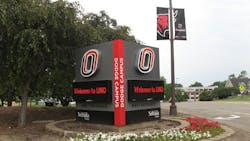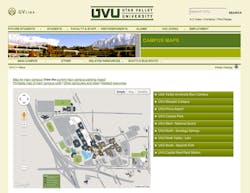Have you ever been lost? Late for an appointment? Of course, everyone has had a feeling of doubt about the ability to navigate, frustration from the lack of information received, and concern that the mistake could cost time, money or, in some cases, safety.
Given the scale of today’s college campus environments, administrators must take steps to help visitors avoid these feelings. In the competitive world of higher education, even the slightest negative perception can have a bearing on where families invest in their children’s future.
Education institutions can help secure this investment by focusing on five areas: hospitality, culture, context, flexibility and user expectations. These form the foundation for an integrated wayfinding program.
And remember, while “simple” is actually quite complex, “simple” is exactly what it should be for a visitor.
Hospitality
It all begins with a shared philosophy about how a school intends to make visitors feel welcome. On any campus, there is an intrinsic complexity that people keep in their heads: the best exit off the highway, how to skirt the athletic traffic during busy times, or which route is the favorite shortcut to the office.
School officials need to assume that someone stepping onto a campus for the first time has none of this knowledge, so it must be shared with them throughout a visit. Information provided before, during and after time spent on campus gives an institution multiple opportunities to reach out with simple, consistent and reassuring messages.
An integrated wayfinding system is designed primarily for a first-time visitor, be it a potential student, parent, staff member, visiting faculty or community member (an alumnus also can fall into this group if significant campus changes have occurred).
A comprehensive approach to wayfinding means that a university has made an internal commitment to “speak in one voice” to its visitors. That means the built environment will be identical, in terms of wayfinding information and logic, to the other ways that the university communicates. Building this system makes the campus more legible, understandable and therefore more hospitable to visitors.
Culture
All higher-education institutions have a unique culture that defines “how things get done around here.” It’s important to understand the constraints and opportunities that internal departments face, and design a process to meet them. Developing a wayfinding system for a large campus brings together departments and individuals that may not have worked together in the past. In addition, a guest’s experience may be viewed as everyone’s responsibility, but it’s not necessarily found in anyone’s job description.
A great wayfinding system starts with an interconnected team of internal departments that understand the responsibility of enhancing a visitor’s experience, and contribute their expertise accordingly. Before a wayfinding team begins to delve into the details of the system, it needs to clarify the team’s objectives and expectations and the process for internal input, review and approvals.
Context
Once the group is organized, the discussion likely will begin with a number of references to the campus context–in this case, the built environment. Campus divisions, boundaries, entrances, streets and pedestrian pathways all will be considered as the team builds a simplified logic for circulation, relative to a given visitor. A good example is to define two distinct campus zones: academic and athletic. A potential student is directed to enter on the academic side, where admissions are housed; for a sports fan, the opposite side of campus works best.
Each internal group must describe the campus context, simply and clearly, to that visitor beforehand: “The volleyball camp takes place in the fieldhouse on the athletic campus. Exit the highway at Spencer Avenue and follow the signs to visitor parking in Lot 10.”
Note that this example does not elaborate on other campus destinations; this visitor does not need to know that there is another side to campus, other potential highway exits or other parking areas. Wayfinding is as much about what schools don’t tell your visitors, as what they do tell them.
Human nature may compel some to suggest a shortcut, based on their familiarity with campus. This runs counter to an integrated wayfinding program, and for that matter, good hospitality. Part of the discussion must center on using consistent language. Once the campus context is simplified, it will be supported with wayfinding signage. Direction-giving must then be consistent across the board, whether verbal, in print, on the Web, in a mobile app or on signage.
Flexibility
A campus of any size is an organic entity. Change is constant, and needs to be reflected accurately in a wayfinding system. A great system is designed to manage changes efficiently and cost-effectively from day one. As change occurs on campus (e.g., a department move to a new building), a number of dominoes that need to fall in order for that change to be fully supported: signage (of course), but also a change to the public website, alumni outreach, student orientation materials, information desk/call center training, etc.
Integrated wayfinding identifies each of these, and creates protocols for changing this information in a timely way based on the responsibilities of each department. This is where the wayfinding team will function most effectively once the system is in place (and beyond). Another beneficial activity is to develop a “charter document” that describes, in detail, each department’s responsibilities. It serves as a valuable and seamless reference when wayfinding team members change.
User Expectations
A college campus is a diverse place, so a variety of tools must be brought to bear on the task of wayfinding. It’s important to define expectations of all types of audiences and understand and prioritize the tools they might use to navigate campus. Anticipating these preferences by incorporating redundancies in wayfinding tools is critical to keeping guests feeling welcomed, supported and confident.
A cohesive wayfinding system considers not only what’s necessary to accomplish this, but also what’s possible given internal resources and available technologies. The logic, language and graphic elements developed for the wayfinding signage will be designed to translate to a variety of media, whether Web-based, mobile or printed. In this way, the entire campus becomes a part of a competitive advantage, because the communications environment is tied seamlessly to the built environment.
Remember the old maxim “first impressions last.” Be prepared to support and empower visitors by emphasizing:
•A foundational focus on hospitality to guests.
•Consideration of the context and culture of the campus.
•Design and implementation by a cross-functional team.
•Using a variety of flexible tools.
•Meeting visitors when and where they require information.
Sidebar: Wayfinding Communications
A guest journey consists of six individual steps. Here are typical internal departments with responsibility for communicating throughout the journey, and the wayfinding tools that must be coordinated:
•Listen: Why should I choose you?
Departments: Marketing/PR, Donor Relations, Alumni Relations.
Tools: Printed materials, website, social media.
•Prepare: What do I need to know?
Departments: Visitor Center, Information Services, Orientation Scheduling, Human Resources, Staff/Faculty Communications, Academic Departments.
Tools: Printed guest materials, orientation training, volunteer coordinator, information desk/call center, mobile app, staff/faculty intranet.
•Arrive: How do I get there?
Departments: Facilities Planning, Security, Parking Services.
Tools: Dept. of Transportation signage, campus boundary signs, campus entry signage, parking identification/regulatory signs.
•Engage: Where do I need to be (and what else can I do)?
Departments: Facilities Planning, Marketing/PR.
Tools: Vehicular and pedestrian directional signs, pedestrian map kiosks, interpretive/dedicatory signs, building/entrance identification signs, mobile app, printed guest maps and information.
•Depart: How do I get home?
Departments: Facilities Planning, Security, Parking Services.
Tools: Pedestrian and vehicular directional signs, pedestrian map kiosks, mobile app, campus boundary signage.
•Support: What’s changed since my last visit?
Departments: Wayfinding Team.
Tools: Regular meetings to ensure consistency regardless of the medium in which wayfinding messages are delivered.
VanderKlipp is president of Corbin Design, Traverse City, Mich., a leader in wayfinding and environmental graphic design throughout North America.

